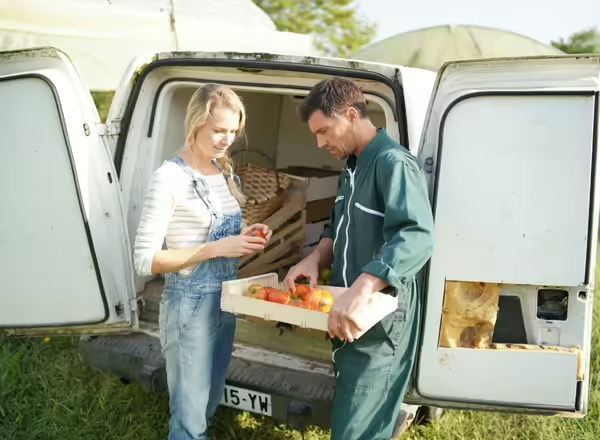Illinois Asset Mapping Initiative
Building resilience in the middle of Illinois' food supply chain
In 2023, the USDA launched the Resilient Food Systems Infrastructure (RFSI) program to strengthen the middle of the supply chain, expand markets for small farms and food businesses, and support value-added product development. The Illinois Department of Agriculture received $6.3 million to invest in this infrastructure through competitive subawards and statewide supply chain coordination efforts, supported by Illinois Extension.

Purpose and Vision
This project will create a map that strengthens the food system supply chain in Illinois, focusing on mapping assets in the middle of the supply chain. The map will be a statewide, public-facing tool visualizing key food system infrastructure across Illinois. By mapping assets such as processing facilities, cold storage, and food hubs, the map will help:
- Producers find reliable options to process, store, and distribute their products
- Policymakers and funders identify infrastructure gaps and opportunities for investment
- Local leaders connect to existing assets, build partnerships, and avoid duplicating efforts
The completed asset map will be a foundation for launching supply chain coordination events and will be part of a larger resource toolkit to support Illinois food system development.
This work builds on insights from statewide listening sessions (2023 Local Food Purchase Assistance Listening Session Learnings and 2025 Food System Roadmap Phase 1 Report) that identified infrastructure gaps as a major barrier to local food system growth. The Illinois Asset Map responds to this community call by mapping existing infrastructure and creating a decision-making tool for farmers, policymakers, funders, and food system leaders.
Landscape Analysis
Before beginning map development, Illinois Extension conducted a landscape review of existing food system and supply chain maps that featured middle-of-the-supply chain infrastructure across the U.S. The analysis identified best practices, data gaps, and lessons learned from other mapping initiatives. These insights are shaping the design of the Illinois Asset Map to ensure it is user-friendly, sustainable, and aligned with stakeholder needs.
Project Timeline
This project is funded through the supply chain coordination portion of the USDA's RFSI program until December of 2026.
- Phase 1 (October 2024 – June 2025) focused on laying the groundwork: defining the map’s scope, identifying assets to include, and exploring potential mapping partners.
- Phase 2 (July-December 2025) focuses on creating the first public version of the map, building community engagement, and establishing sustainability plans.
- Phase 3 (TBD) will focus on gathering community feedback on the map, leading community-driven mapping events, and developing case studies of infrastructure success stories.
Steering Committee
A steering committee of food system stakeholders, including farmers, researchers, and food system leaders, is guiding the map’s development. Makala Bach, Food Systems Outreach Associate at Illinois Extension, is the main point of contact for the project and the facilitator for the steering committee.
Committee Members
- Dr. Howard Rosing: Professor & Researcher at DePaul University, Executive Director of Steans Center
- Ritchie Wai: Farmer Incubator Coordinator at Farmers Rising, Member of National Young Farmers Coalition
- Jeff Hake: Local Food Policy Organizer at Illinois Stewardship Alliance, Facilitator of Illinois Food Systems Infrastructure Collaborative, Farmer at Funks Grove Heritage Fruits and Grains
- Justin McElderry: Food Systems Innovation Fellow at Illinois Institute of Design at IIT
- Megan Murphy: Farmer at Backyard Beauty, Collective Impact Steward, Writer
- Anya Knecht: Farmer at Anya Farm and Systems Engineering Consultant
Get in Touch
Interested in learning more? Reach out to Makala Bach at bachmak@illinois.edu.
Frequently Asked Questions
What makes this map different?
It focuses on middle-of-the-supply-chain infrastructure, also known as the “missing middle”, connecting producers to processors, aggregators, and markets.
What kinds of infrastructure will be included?
The map will focus on key middle-of-the-food-supply-chain assets such as processing facilities, food hubs, and aggregation sites.
What do you mean by middle-of-the-supply-chain?
The USDA defines the middle-of-the-supply chain as any activity that occurs after production and before it reaches the consumer. This includes all activities related to processing, aggregation, and distribution.
There are a lot of mapping projects in Illinois! Have you connected with them?
Probably! We’ve connected with MarketMaker, Builder’s Vision, their Supply Chain Infrastructure Map, and the Community Food Mobilization in Chicago (CF-MOB) mapping effort led by Dr. Howard Rosing and the Chicago Food Policy Action Council. We also connected with other middle-of-the-supply-chain mapping initiatives across the United States as part of the Asset Map Landscape Analysis.